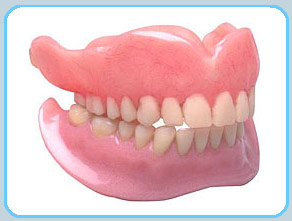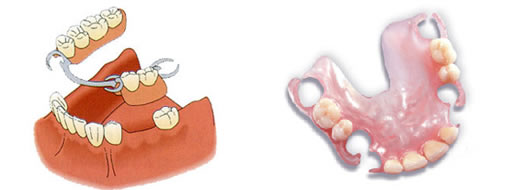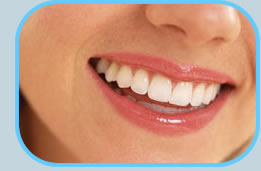
Full and Partial Dentures at Torgersen Dental, Camarillo & Simi Valley
 If you choose dentures to substitute missing teeth, we can design and create and fit a natural-looking denture that will not slip. Modern technology allows us to anchor a denture plate securely so that there's little need for you to worry about the foods you eat as well as falling and moving dentures. It will surely make your life much more comfortable.
If you choose dentures to substitute missing teeth, we can design and create and fit a natural-looking denture that will not slip. Modern technology allows us to anchor a denture plate securely so that there's little need for you to worry about the foods you eat as well as falling and moving dentures. It will surely make your life much more comfortable.
In More Details...
A denture is a removable replacement for missing teeth and surrounding tissues. There are 2 types of dentures available: complete and partial dentures. When all the teeth are missing, complete dentures are used. However, when some natural teeth remain, partial dentures can be used.
Complete Dentures
Complete dentures can be either "conventional" or "immediate" and made after the teeth have been removed and the gum tissue started to heal. A conventional denture is ready for the placement in the mouth in 8 to 12 weeks after the teeth have been removed.
Unlike conventional dentures, immediate dentures are made in advance and can be placed as soon as the teeth have been removed. As a result, the wearer does not have to be without teeth during the healing period. However, bones and gums shrink over time, especially during the healing period following tooth removal. Immediate dentures require further modifications to fit properly during the healing process and generally should be considered only a temporary solution until conventional dentures can be constructed.
Partial Dentures
Removable partial dentures typically consists of replacement teeth anchored to a pink or gum-colored plastic base, into which is embedded a metal framework that holds onto the remaining supporting teeth with metal clasps which holds the denture securely in the mouth. Partial dentures are used when one or more natural teeth remain in the upper or lower jaw. A partial denture not only fills in the spaces created by missing teeth but it also prevents other teeth from shifting their position. A "precision" partial denture is removable and has (hidden) internal attachments that make it a more natural-looking device, rather than visible external metal clasps that connect the standard partial denture to the supporting crowns.
Another alternative partial denture is the all plastic flexible "Valplast" partial denture. Although there are limitations to its use, the benefits are that there are no metal clasps that can wear the anchoring teeth or put abnormal forces to the supporting teeth.
 Partial Dentures
Partial DenturesAlternatives to Dentures
Dental implants are useful since they can hold permanently cemented bridges, eliminating the necessity for a denture. The price is normally higher, however, the implants and bridges more closely resemble the feel of real teeth. Dental implants are becoming the alternative to dentures but not everyone is qualified for implants. Consult Dr. Trent and Gina Torgersen for recommendation.
Construction of Dentures
The denture development process takes about 3 weeks to 1.5 months and requires several appointments. Once Dr. Trent and Gina Torgersen determine what type of device is best for you, the general steps include:
- Take several impressions of your jaw and take evaluations of how your jaws related to one another and how much space is in between them.
- Create models, wax forms, and/or plastic patterns in the exact shape and position of the denture to be made. You will "try in" this model a few times. The denture will be evaluated for color, shape, and fit before the final denture is molded.
- Mold a final denture.
- Adjustments will be made as needed.
Effects of Wearing Dentures
To your Feelings...
 New dentures may feel a little odd or loose for several weeks until the muscles of your cheeks and tongue learn to keep them in place and you get comfortable inserting and removing them. It is not unusual to have minor irritations or inflammation and for saliva flow to increase when you first start wearing dentures, but these difficulties will disappear as your mouth adjusts to the new denture.
New dentures may feel a little odd or loose for several weeks until the muscles of your cheeks and tongue learn to keep them in place and you get comfortable inserting and removing them. It is not unusual to have minor irritations or inflammation and for saliva flow to increase when you first start wearing dentures, but these difficulties will disappear as your mouth adjusts to the new denture.
To your Looks...
Dentures are designed to carefully mimic your original teeth so there should be no apparent change to your physical appearance. The truth is, dentures may actually enhance your smile and complete your overall look.
To your Eating Habits...
Eating with new dentures will take a little practice and may be awkward for some wearers for a few weeks. To get accustomed to the new denture, it is best to begin with soft foods cut into small pieces. Chew gradually with the use of both sides of your mouth. As you get used to your new dentures, add other foods until eventually you go back to your usual diet. Be careful with hot or hard foods and sharp-edged bones or shells. Moreover, avoid foods that are extra sticky or hard. Avoid chewing gum while you adapt to the denture. Also, do not use toothpicks when having your dentures on.
To your Talking...
Initially after you obtain dentures, you may have trouble pronouncing specific words. If that is the case, practice by saying the difficult words out loud. With practice and time, you will be able to speak properly while wearing your denture.
In the event that your dentures "click" while you are talking, you must contact Dr. Trent and Gina Torgersen. Your dentures may sometimes slip when you laugh, cough, or smile. Reposition the dentures by means of gently biting down and swallowing. Whenever any speaking problem continues, seek advice from Dr. Trent and Gina Torgersen.
Dr. Trent and Gina Torgersen will advise you as to how long to put on your denture and when to take it off. During the first several days right after getting your denture, you may be possibly required to wear it all the time, as well as while you sleep. Despite the fact that this may be temporary uncomfortable, it is the fastest way to determine the areas on your denture that may require modification.
As soon as adjustments are made, you will need to remove your dentures before going to bed. This allows gum tissues to relax and permits normal stimulation and detoxification by the tongue and saliva. The denture can be put back in your mouth in the morning.
A denture adhesive may be taken into consideration when it:
- Improves your fulfillment with an accurately designed denture. Adhesives enhance retention, stability, bite force, and sense of protection.
- Helps individuals with dry mouth conditions that lessen denture adherence, such as people taking cold medications, those with neurological ailments including strokes, and aging adults.
- Provides additional stability and safety for those who place uncommon requirements on their facial muscles, such as public speakers or musicians.
The following situations show when denture adhesives should not be used:
- When it is utilized as a "fix" for ill-fitting or improperly manufactured dentures. If your dentures start to feel loose, causing irritation or causing sores to build up, contact Dr. Trent and Gina Torgersen immediately.
- When a dentist has not examined your dentures for a long period of time. Dentures relax on gum tissue and your jawbone, which reduces in size and weaken, respectively, as time passes. For this reason, the actual problem may possibly be a need for a denture correction or completely new dentures.
- When dental hygiene routines cannot be maintained.
- When any identified allergy or intolerance exists to the adhesive's substances.
Proper Application of Denture Adhesives
Tips to consider when applying denture adhesives:
- Use the minimal quantity required to supply the optimum adhesion. Apply a smaller amount than you think you need, and then slowly increase the amount until you truly feel comfortable.
- Spread the adhesive uniformly on the tissue-bearing surface of the denture.
- Apply or reapply when needed to produce the desired result.
- Always apply the adhesive to a thoroughly clean denture.
- Keep in mind that adhesives function best with a well-fitting denture.
Types of Denture Adhesives
Paste application.Apply this denture adhesive to a dry or preferably wet denture. Keep away from putting adhesive close to the denture edges. If the adhesive oozes, use less of the product. For dentures on the top jaw, apply 3 short strips of adhesive - or 3 series of tiny dots - along the ridge area and one down the middle. For dentures on the lower jaw, apply 3 short strips of adhesive - or 3 series of tiny dots - in the middle of the ridge area.
Powder application. Sprinkle a thin, even layer all over the tissue-bearing surface of the denture. Remove unwanted powder and press the denture into place. Powders may be recommended more than pastes because they are less complicated to clean off the denture and tissue. Moreover, they tend not to have the same inclination as pastes do to "shim" (keep the denture away from the tissue).
Denture Adhesive Precautions
Dental adhesives are risk-free as long as they are used as instructed. If the denture is well- fitted and the adhesive is only used to give added stability, there should be no dangerous results. If too much adhesives is used to fill voids for an ill-fitting denture, it can be unsafe to the underlying soft and hard tissues. At times, in these instances, swelling of the soft tissues can result. Furthermore, because of its movement on the soft tissue and underlying bone, an ill-fitting denture can cause bone damage.
Call for your appointment today!


